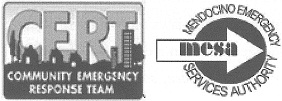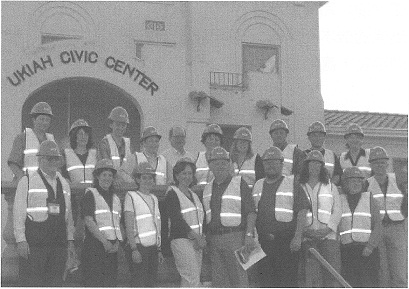|
上個月對我轉變最大的一個經驗,就是參加瑜伽市的首度「社區緊急應變隊」計畫的訓練。我接受聯邦緊急管理署,曼都仙諾緊急服務專局指導員及瑜伽市消防隊的教師們的訓練和上課。
一九九三年起,聯邦緊急管理署在美國二十八個州的社區與波多黎各地區,提供的災難準備訓練,是全國性的服務,在大災難來襲時,災區居民靠自力至少可以維持七十二小時。「社區緊急應變隊」計畫對本市是一個很新的項目,它在一個寬敞的空間─在消防隊裡,教育參加的民眾有關當地可能面臨的危險公害。訓練他們基本災害的應變技術,例如消防安全,簡易搜索與救援,應變隊的組織,以及災害醫療運作等。我很榮幸有機會在「社區緊急應變隊」受訓學習,和許多願意奉獻的教師和英雄共事,他們讓我更進一步體會到佛教徒在災害來臨期間,倡導無緣大慈,(無私的奉獻,珍惜生命)與同體大悲(與人類、動物與自然)的觀點。
在未來萬佛聖城前,我在洛杉磯市上公立學校,經歷過一九八七年惠提爾市的五點九級地震,以及一九八九年北嶺七級的地震。我至今仍記得:地震是清早來襲,而且天色是一片漆黑。在經過兩次挾帶多次餘震的主要地震後,我已經學習到:如何在一個地震常規中求生存。最基本的事,是要每次都儘速跑出屋外,到通常聚會的地方,或到與鄰居共通的前院,並檢查是否大家都安全無事。我對其他生存技巧知道得很少,而且在震災以後的生活中該做什麼,有許多事還有待學習;所以早在十四歲時,就在我腦中種下一個種子(願望),長大後要協助社區工作一段時間。在我大學畢業後,經過一段長時間,鼓足勇氣,辭去我在建築業的工作。當我終於做到了,又如願在萬佛聖城園區和曼都仙諾教育局的教育社區服務;我很幸運能遇到吉姆‧克萊耐先生,他是瑜伽市「社區緊急應變隊」的隊長,他介紹我參加四月四日的第一堂社區緊急應變課。
我的主要工作在建築與電腦技術方面,我大部分的時間和建築師、設計師,老師與學生溝通。「社區緊急應變隊」的項目協助我更加瞭解我所居住的地區──從曼都仙諾、漢堡、迪諾地、索諾瑪和沿湖諸縣──的地質與自然狀況。這個地區學生數量,雖然只佔全加州學生的百分之二;卻涵蓋全州土地面積的百分之十,而且大部分地區是崎嶇而偏遠。加州州長緊急服務辦公室指出,這地區至少有十六種公害事故,包括地震、火山、海嘯、土石流、洪水和野火等。
我鼓勵每個人都參加這個有意義的訓練,以學習基本的災害應變智能。當你學得如何保護自己的生命財產,你也已經減輕了社區、本州乃至於國家的損失;更何況,你還夠格去保護其他眾生的生命與宇宙的物資呢!讓我們把關懷擴展到宇宙間所有的生命與資源,一起來付諸行動吧!

|
|
The most transforming experience that occurred last month was my training in “disaster preparedness” at the first Community Emergency Response Team (CERT) program in Ukiah.
I received this training with, and learned from members of FEMA─Federal Emergency Management Agency, MESA─Mendocino Emergency Services Authority speakers, and the Ukiah Fire Department (UFD) instructors.
This disaster preparedness training has been provided through the CERT. It has been made availabe by FEMA nationwide to 28 U.S. States as well as to Puerto Rico, since 1993. It educates and enables victims of major disasters to be self sustaining for a minimum of 72 hours─ during any major disaster. The CERT program is very new to Ukiah, and it educates participating citizens in a comfortable space ─at the fire station, for hazards that may impact their area. Participants receive training in basic disaster response skills, such as fire safety, light search and rescue, tea m organization, and disaster medical operations. I am honored to have had the opportunity to participate in the CERT training and to have worked with so many dedicated teachers and heroes who made me better understand the Buddhist view of helping to promote love (selfless giving, cherishing lives) and harmony (with people, animals, and nature) during a disaster.
Before moving to the City of Ten Thousand Buddhas, I had attended public schools in Los Angeles, where I had survived the Whittier Narrows Earthquake (5.9 magnitude) in 1987 and the Loma Pieta Northridge Earthquake (7.0 magnitude) in 1989. I still remember how early the earthquake went off and how dark the light was in the morning. After two major earthquakes with many aftershocks, I had learned how to live through an earthquake routine. The basic thing to do was to constantly run out of the house (as quickly as possible) to the usual meeting place, the front yard with our neighbors and check if others were safe. Knowing very little about other survival skills as well as what needed to be done in the aftermath of a disaster, I planted an early seed (wish) in my mind, at age 14, to help out in community works for a while. It took me a very long time after college and enough guts later to quit my architecture job. When I finally did, and fulfilled my wish to serve at the CTTB campus and the education community at Mendocino County Office of Education (MCOE), I had the good fortune to meet with Jim Cline, Ukiah CERT team leader, who referred me to the first CERT class on April 4.
Most of my work revolves around architecture and computer technology, and I spend most of my days interacting with architects, designers, teachers and students. The CERT program helped me better understand the geographical and natural make-up surrounding the area where I live, from Mendocino, Humboldt, Del Norte, Sonoma and Lake Counties. This region serves 2 percent of the state’s students, yet it covers 10 percent of the state’s land area, and for the most part is rugged and remote. At least 16 hazards are identified by the California Governor’s Office of Emergency Services in this region. They include earthquakes, volcanoes, tsunamis, landslides, flooding and wildfires.
I would like to encourage everyone to join this meaningful training to learn the basic disaster response knowledge and skills. While you learn how to protect yourself and your belongings, you actually are helping to reduce the damage of the community, the state and the nation. Besides, you will have qualified to help protect other beings’ lives and substances of this univers. Let’s expand our caring concern to all lives and resources in this universe and put it into action!

|